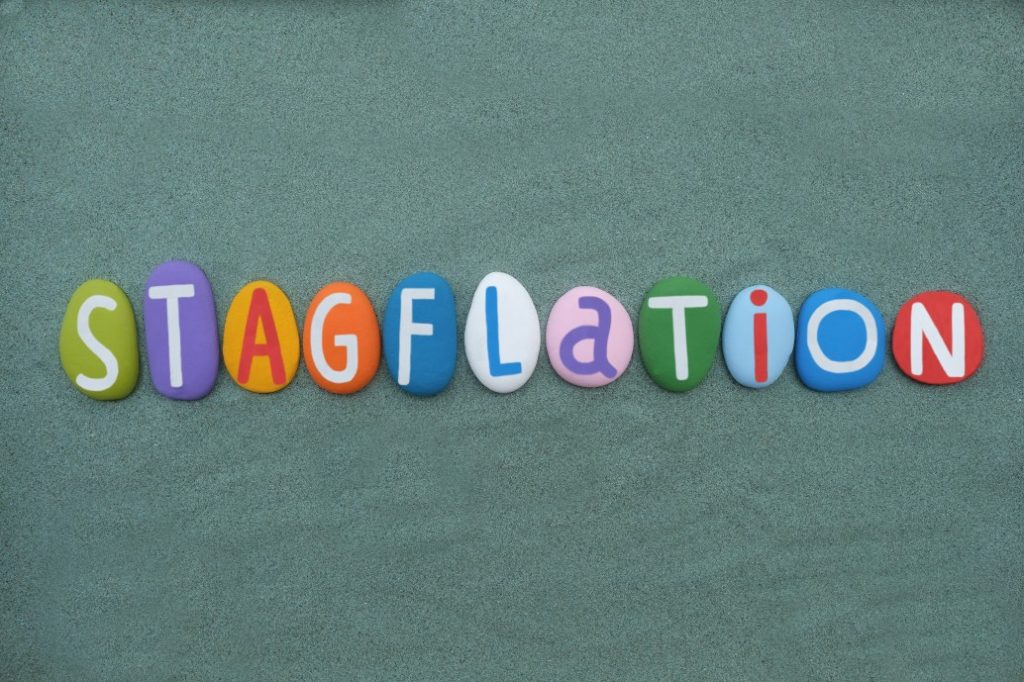What Is Stagflation?
Rising prices often characterize the markets at this time. Stagflation is often the result of poor economic policies. Mismanagement of the economy will lead to periods of slow economic growth, high unemployment, and economic stagnation. The key variables are high inflation and stagnating/declining Gross Domestic Product (GDP).
Economists first began using the term “stagflation” in the 1960s. The economy was facing stress, and it was used to describe the recessionary period in the 1970s due to the oil embargo placed on the U.S. During this period, the U.S. had five consistent quarters of negative GDP growth. The inflation in the economy was rising very quickly while employment rates across the population were falling. Inflation doubled during 1973, and unemployment hit 9%.
The study of periods of Stagflation in the economy led to the emergence of the misery index. This measurement was the simple sum of the inflation rate and unemployment rate. It was helpful for economists to determine how badly consumers struggled when Stagflation hit the economy. Stagflation is considered a real-world phenomenon that is rare. The economic data captured during Stagflation shows that widely accepted economic theories and policy prescriptions aren’t always correct. Inflation often persists even during periods of poor economic growth. In the last 50 years, recessions in the U.S. have experienced a continuous, year-over-year rise in the consumer price level.

Causes of Stagflation
Oil Supply Shocks
In 2021 it was estimated that the U.S. consumed 19.78 million barrels of petroleum daily. The U.S. industrial sector depends heavily on oil for the energy sector. The country would suffer significant consequences in the event of a bottleneck. A sharp & unexpected increase in the price of fuel leads to a reduction in the economy’s productive capacity. The U.S. last experienced fuel scarcity in October 1973. The Middle Eastern countries that supply the majority of the world’s oil issued an oil embargo against the U.S. to sanction them for protecting Israel. The U.S. is a significant producer of the global economy, meaning any price increases in their country can affect the world. As prices rose across the globe dramatically, Stagflation soon appeared as there were increasing costs of goods and a rise in unemployment levels. As the cost of moving products to shelves increased, prices rose even as people were retrenched.
Poor Economic Policies
A stagnating economy and inflation often happen to an economy because of poorly made economic policy. Businesses need a lenient environment conducive to the markets, goods, and labor. When the environment is inflationary, and citizens lose faith in the currency, Stagflation can occur. President Richard Nixon’s fiscal and monetary measures are often said to be the cause of America’s Stagflation in the 1970s.
What Is Disinflation?
Disinflation happens in an economy when there is a temporary slowing of the pace of price inflation. When prices begin to slow down, economists use this term to describe instances when the inflation rate has reduced marginally. The reduction often takes place over the short-term quarter. This term is unlike inflation and deflation. These two are used to explain the direction of prices in an economy. When dealing with disinflation mainly refers to the rate of change in inflation. Disinflation is necessary to help economies from overheating. The main problem with long periods of disinflation is that when the inflation rate falls near zero, it can lead to deflation. Disinflation is often healthy for the economy as stocks perform well. Deflation, conversely, can be harmful. Disinflation doesn’t mean prices are falling. It is not a signal of a slowing economy; however, Stagflation is a negative growth rate.

Causes of Disinflation
Tighter Monetary Policy
When the central bank introduces a more stringent monetary policy, it reduces the money supply in the economy. The government often complements these efforts by selling off its securities. These measures often result in a disinflationary effect.
End of Business Cycle/ Recession
When the business cycle of the industry comes to an end, it is likely to trigger disinflation. When this cycle ends, businesses may choose not to increase prices to gain a more significant market share. This mismatch can lead to disinflation. The most extended period of disinflation in the U.S. occurred between 1980 and 2015. This period was preceded by the 1970s, a period of significant inflation known as the “Great Inflation.”
Why is Stagflation Bad?
- Loss of consumer purchasing power
High rates of inflation commonly occur during Stagflation. The inability to store value in the currency leads to the higher cost of goods and services. This feature will often reduce the actual value of money.
- Rising interest rates
To combat inflation, it is likely that the Federal Reserve will increase interest rates to reduce the money supply. This measure will make it harder for consumers to access capital resulting in lower investment levels.
- Lower corporate earnings
Poor economic performance will often lead to higher input prices and lower sales. This feature has the effect of reducing corporate earnings. Lower profits generated by businesses will lead to falling stock prices and underperforming markets.
- High unemployment rates
Given the lack of success in business experience during Stagflation. The upper management will likely try and protect the earnings’ bottom line. The company will try to create a buffer of extra capital by reducing its workforce.
Conclusion
Disinflation is commonly experienced during healthy periods in the economy. When Stagflation happens, it is generally in an environment of high inflation. The increased inflation leads to the government introducing rising interest rates. To cope with money supply pressures, businesses often retrench employees leading to higher unemployment. Disinflation is a positive thing and often the opposite of the slow to no economic growth experienced. Consumers feel the pinch as their purchasing power decreases, leading to less spending.






































